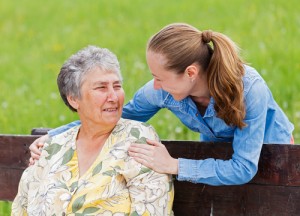
With an ageing population, there are more and more older adults who require health and social care resources. In England, these are supported by Community Mental Health Teams for older people (Wilberforce et al., 2013; 2015). One way to help these older adults in a less costly manner is care co-ordination.
Care co-ordination is meant to help people access the services they need and consists of four main elements (Challis et al., 2002):
- Face-to-face assessment of physical, psychological and social functioning;
- Identification of service needs;
- Access to services;
- Ongoing monitoring of needs.
In fact, care co-ordination is mostly found effective with many positive outcomes, such as reduced mortality, improved well-being, and delayed nursing home admission, which means that older adults can live more independently at home for longer. In return, this can reduce the amount of informal caring work undertaken by family and friends. However, some studies, including randomised controlled trials, have found care co-ordination to be as effective as mere information provision and referral to suitable services.
In this blog, I look at a recent study by Scharlach and colleagues (2015) from the School of Social Welfare at the University of California, Berkeley. These researchers wanted to know whether a co-ordinated community-based care service, called ‘ElderHelp Concierge Club’, is an effective way of support vulnerable older adults in the community.
Volunteers at the ElderHelp Concierge Club provide these seven different types of support:
- Driving
- Grocery shopping
- Housekeeping
- Home maintenance and repair
- Financial advocacy
- Friendly visiting
- Pet care

The researchers investigated the impact of an older people’s co-ordinated community-based service
Method
The authors performed a retrospective study with 96 members of the club who had received services. For this purpose, the authors conducted telephone interviews and asked the members whether they had received the seven services on offer and how these services had affected their day-to-day life.
The authors also performed a prospective study with 21 members. For this study, members were asked to complete measures on physical well-being, activities of daily living, falls, mobility, psychological well-being, home safety and health service use both at the beginning of the club membership and after six months.
Findings
In the retrospective study, the authors showed that being a member of the club is helpful to one’s day-to-day life.
The most frequently used service was driving, followed by help to go shopping. The service used the least was pet care. People having received those service reported between 60% (social interaction) and 100% (e.g. home safety) satisfaction and improvements in these areas.
In the prospective study, people reported significantly fewer falls, but there was no effect on well-being or activities of daily living. Also, people reported to be more likely to have their medical needs met, and to leave the house.

Members of the club receiving support with day to day things like driving and shopping reported significantly fewer falls.
Conclusion
The authors conclude that
This study provides preliminary evidence that an integrated multilevel care co-ordination approach may be an effective and efficient model for serving vulnerable community-based elders, especially low and moderate-income elders who otherwise could not afford the cost of care.
Strengths and limitations
This study has a couple of minor limitations. Firstly, as mentioned by the authors, the retrospective study may be biased as it is based on self reports. Considering the ageing population accessing those services, some of which may have dementia and may have memory problems, the reports of improvements may be overestimated. Secondly, the prospective sample is relatively small, and a larger sample may have yielded further insights.
Summing up
Overall, this study shows the benefits of a simple support service which helps older adults accessing services through driving support or going to the local supermarket. It is these basic things that can make a huge difference to the life of an older person, and is probably something we don’t think about whilst we are still young and able to do all these things easily!
The study benefits from having two components, and not solely relying on retrospective self-reports. However, further research is needed. Although the study indicates positive impacts, some effects may not have been powerful enough in a small sample of 21 participants. In conclusion though, care co-ordination for vulnerable older adults appears to be an effective support model, as previous research has also suggested.
Although we are not part of a formal care co-ordination system, maybe we should all try and do one small thing for an older neighbour, and if it’s just a friendly visit or a lift to the shops every once in a while?

Given evidence on the benefits of support with simple daily tasks, maybe we should all try to do one thing for an older neighbour now and then?
Link
Scharlach, A.E., Graham, C.L., & Berridge, C. (2015). An Integrated Model of Co-ordinated Community-Based Care. The Gerontologist, 55 (4), 677-687. [Abstract]
References
Challis DJ, Chesterman R, Luckett R, Stewart KJ, & Chessum R. (2002). Care management in social and primary health care: The Gateshead Community Care Scheme. Aldershot: Ashgate
Wilberforce, M., Tucker, S., Abendstern, M., Brand, C., Giebel, C.M., & Challis, D. (2013). Membership and management: structures of inter-professional working in community mental health teams for older people in England. International Psychogeriatrics, 25 (9), 1485-1492. [Abstract]
Wilberforce, M., Tucker, S., Brand, C., Abendstern, M., Jasper, R., Stewart, K., & Challis, D. (2015). Community mental health teams for older people: variations in case mix and service receipt (II). International Journal of Geriatric Psychiatry, 30 (6), 605-613. [Abstract]

More super evidence blogging from @ClarissaGiebel @SocialCareElf -coordinated community care & help they neighbour http://t.co/PVoQDCdMcS
@Intipton @SocialCareElf danke! Just in Berlin at a conference, I had forgotten about my blog! :-)
@ClarissaGiebel @SocialCareElf have a great conference.
Whilst in Berlin, read my @SocialCareElf blog on community care for older adults http://t.co/VMY2ZdbuRk @SNMSWResearch @M_Wilberforce
RT @SocialCareElf: Today @ClarissaGiebel discovers that little things still mean a lot for community support & prevention #olderpeople http…
Study shows that supporting older people with shopping and driving can help prevent falls http://t.co/LW4r7PRCRq #socialcare #wellworthit
@SocialCareElf shame on supermarkets making £40 minimum for delivery or charging £4. Where has philanthropy gone?
@margaretOT360 @SocialCareElf Agreed that £40 is a lot, but you need to take into account the petrol charge as well for the drivers?
Don’t miss: The impact of co-ordinated community-based care for older people http://t.co/HPcS14XwdG #EBP
RT @SocialCareElf: How to catch older people before they fall: co-ordinated community support can help fall reduction http://t.co/Z1fbHtmC3…
New @socialcareelf blog on community based services for older adults http://t.co/Ewn55d3R4L @SCIE_sco @SocialCareDirec #socialcare
RT @AlanHattonYeo: Good blog the little things in communities that make a difference for older people http://t.co/oi6hItb0lV @AgeingWellCym…
Article (pdf) sobre l’alt impacte dels #serveissocials bàsics en la prevenció i qualitat de vida de la #gentgran
https://t.co/n5s96WrJ7T
‘The impact of co-ordinated community-based care for older people’ via @SocialCareElf http://t.co/HPxSbX3LPI
From the Social Care Elf: The impact of co-ordinated community-based care for older people https://t.co/TpEbpDCiLE via @sharethis
Interesting blog on co-ordinated community-based #care for older people https://t.co/Ewn55d3R4L @SocialCareElf @NSMNSS @SCIE_socialcare